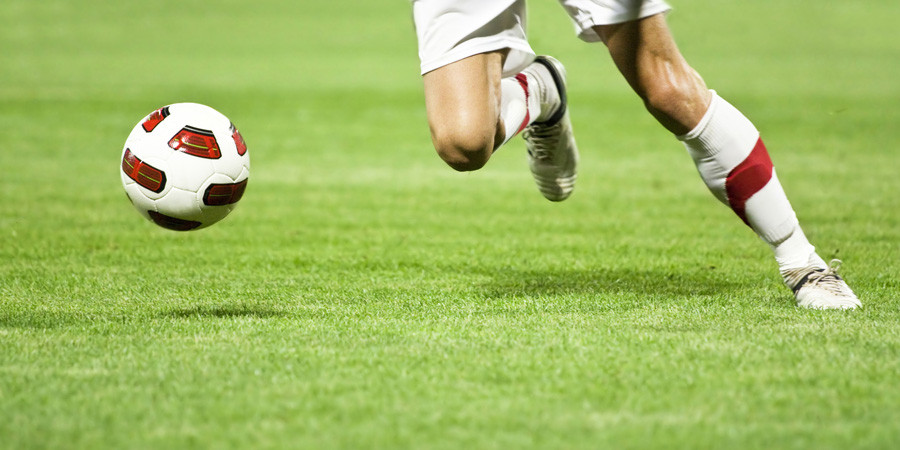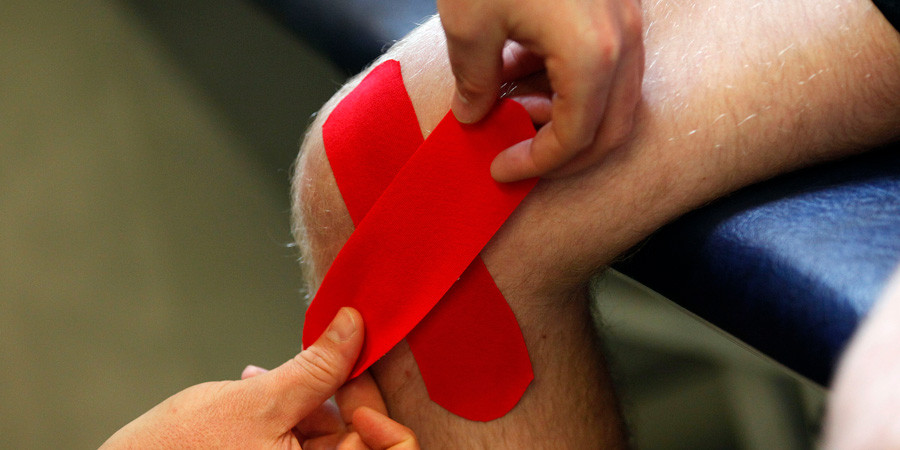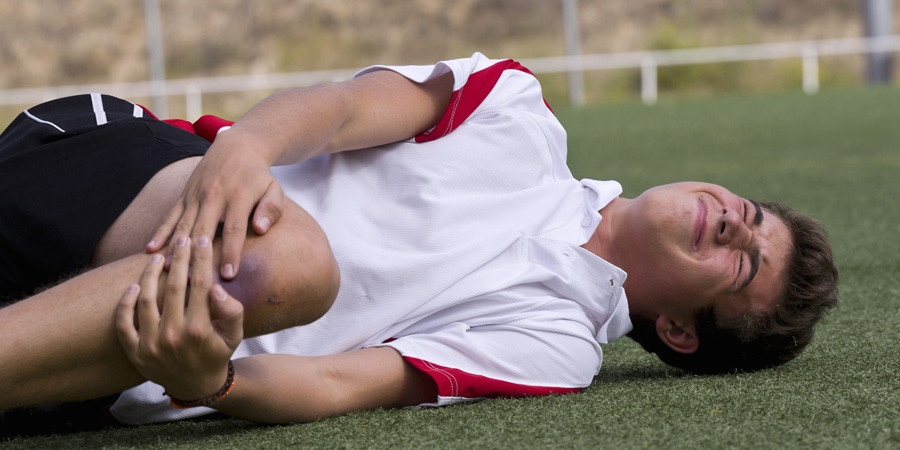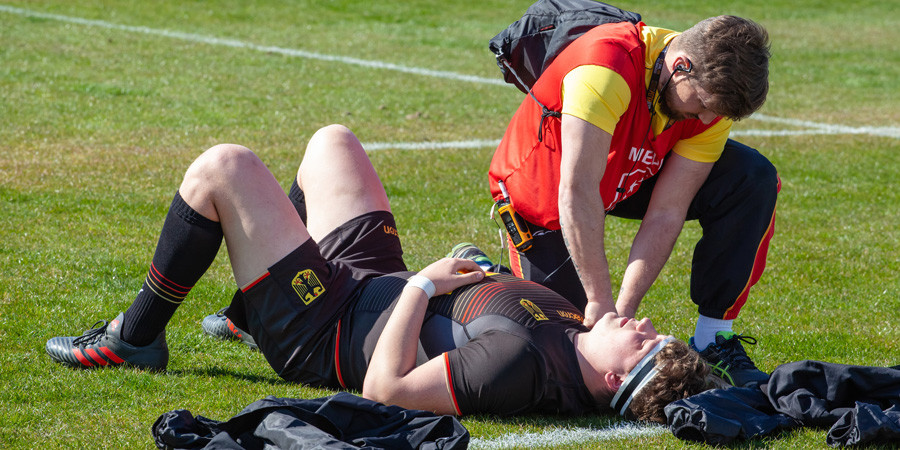Are you looking for the best way to tape your knee for football to prevent injuries or support existing conditions? This guide provides detailed instructions and techniques on how to effectively use sports tape for knee support, helping you stay in the game. At CAUHOI2025.UK.COM, we are dedicated to offering reliable and easy-to-understand information to keep you informed and active. Learn about different types of sports tape and how to apply them properly, plus discover expert tips to minimize pain and enhance performance, with additional resources on injury rehabilitation.
1. Understanding Knee Pain in Football
Knee pain is a common issue in football, often stemming from high-impact collisions, sudden twists, and overuse. Knowing the types and causes of knee pain is crucial for effective prevention and treatment.
1.1. Common Knee Pain Problems in Football
- Patellar Malalignment: The kneecap moves out of its correct position, leading to pain and instability.
- Meniscus Injuries: Tears or inflammation in the cartilage that cushions the knee joint. According to the American Academy of Orthopaedic Surgeons (AAOS), meniscus tears are prevalent in athletes due to sudden stops and pivots.
- Arthritis: Inflammation and swelling in the joints, common among older athletes.
- Infrapatellar Fat Pad Syndrome: Irritation of the fat pad beneath the kneecap.
- Plica Syndrome: Irritation of the connective tissue membrane in the knee.
- Chondromalacia: Breakdown of cartilage under the kneecap.
1.2. Causes of Knee Pain in Football
- Poor Technique: Incorrect running or landing techniques can strain the knee joint.
- Hip Misalignment: Misalignment can affect knee mechanics and increase the risk of injury.
- Overtraining: Pushing the knee joint too hard without adequate rest.
- Hyperextension: Extending the knee beyond its normal range of motion.
- Hard Impacts: Direct blows to the knee from falls or collisions.
- Inappropriate Footwear: Wearing shoes that don’t provide adequate support and cushioning.
- Over Twisting: Twisting the knee excessively, especially while bearing weight.
- Poor Nutrition: Inadequate intake of nutrients essential for joint health.
- Genetic Predispositions: Certain genetic conditions can increase the risk of knee problems.
 Footballer Running
Footballer Running
2. Does Sports Tape Help with Knee Pain in Football?
Yes, sports tape can significantly help with knee pain by providing support, reducing pressure, increasing blood circulation, and maintaining a safe range of motion during healing. Proper application of sports tape can alleviate pain and prevent further damage, making it an essential tool for football players.
3. Best Types of Sports Knee Support Tape for Football
Selecting the right type of sports tape is essential for effective knee support in football. Here are the two primary types:
3.1. Elasticated Kinesiology Tape
Kinesiology tape, or K-tape, is designed to mimic the skin’s thickness and weight. Made from stretchy cotton with a hypoallergenic adhesive, it offers flexibility and support without stiffness.
- Benefits: Relieves pressure around the knee joint, provides stability, and allows a reasonable range of motion. According to a study in the Journal of Sports Science & Medicine, kinesiology tape can improve proprioception and reduce pain in athletes with knee injuries.
- Recommended Use: For long-term sports rehabilitation and lymphatic drainage.
 Kinesiology Tape on Knee
Kinesiology Tape on Knee
3.2. Rigid Sports Tape
Rigid, non-stretch sports tape is excellent for stabilizing the knee cap and aligning the joint to reduce pain.
- Benefits: Provides strong support and limits excessive movement.
- Recommended Use: For acute injuries requiring significant stabilization.
4. Effective Methods of Sports Taping Knee for Support in Football
Here are two effective methods for taping the knee to provide support and prevent injury in football:
4.1. How to Strap a Knee with Sports Tape Using the McConnel Technique
The McConnel technique is ideal for treating patellofemoral pain syndrome (PFPS), commonly known as ‘runner’s knee’ or Hoffa’s fat pad syndrome.
4.1.1. The McConnel Technique: Step-by-Step Guide
You’ll Need:
- Underwrap (or adhesive gauze)
- 3.8cm-wide rigid athletic tape
- Scissors
Application Process:
- Preparation: Sit with the leg stretched out and slightly bent, ensuring the quadriceps are relaxed.
- Apply Underwrap: Wrap the area with underwrap to protect the skin.
- First Strip: Cut a 15cm strip of rigid sports tape.
- Application: Start in the middle of the knee cap and pull the tape towards the inner part of the knee, pushing the soft tissue outwards towards the knee cap.
- Secure: Ensure the tape feels supportive and isn’t painful.
- Additional Strips: Continue applying rigid sports tape in other directions as needed.
- Finalize: Secure the end of the tape neatly on the inner side of the kneecap.
This support can typically remain in place for up to 18 hours.
4.2. How to Wrap a Knee with Sports Tape Using Kinesiology Tape
Kinesiology tape is beneficial for knee joints that require a comfortable range of motion to heal.
4.2.1. Basic Kinesiology Technique: Step-by-Step Guide
You’ll Need:
- Kinesiology tape strips
- Scissors
Application Process:
- Prepare the Skin: Ensure the skin is clean and dry.
- Position: Sit on a bench with the knee bent.
- Measure and Cut: Measure from the tibial tubercle to the quadriceps tendon and cut two strips of kinesiology tape to that length, rounding the corners.
- First Strip: Peel off an inch of the end of one strip and adhere it to the outside of the tibial tubercle.
- Wrap: Stretch the tape by 40% and wrap it around the inner knee, securing the end without stretching.
- Second Strip: Repeat the process from the other side, forming an X shape.
- Under Kneecap Support: Cut a new strip long enough to wrap under the kneecap. Straighten the knee slightly.
- Apply: Stretch the center of the strip to 80% and adhere it under the kneecap, wrapping the ends along the hamstring.
When applied correctly, kinesiology tape can stay on for 3-5 days.
 Knee Injury Football
Knee Injury Football
5. Using Sports Tape for Specific Knee Pain Conditions in Football
Sports tape can be tailored to address specific knee pain conditions common in football players.
5.1. How to Strap a Knee with Sports Tape for Medial Knee Pain
Medial knee pain occurs on the inside of the knee joint, often due to meniscus sprains, patellar tendonitis, or MCL injuries.
5.1.1. Kinesiology Technique for Medial Knee Pain: Step-by-Step Guide
You’ll Need:
- Kinesiology tape strips
- Scissors
Application Process:
- Prepare: Ensure the skin is clean and dry.
- Cut Strips: Cut one 25cm strip and two 13cm strips, rounding the edges.
- Position: Sit with the knee bent at a right angle.
- First Strip: Adhere the first 3cm of the 25cm strip to the upper calf below the inner side of the knee joint.
- Wrap: Stretch the tape to 10% elasticity and wrap it around the inner knee joint.
- Smaller Strips: Stretch the center of the first 13cm strip to 80% and place it directly over the site of the pain.
- Create X Shape: Repeat with the remaining 13cm strip to create an X shape over the pain site.
5.2. How to Put Sports Tape on Your Knee for Anterior Knee Pain
Anterior knee pain is located at the front and center of the knee, often caused by arthritis or patellofemoral pain syndrome.
5.2.1. Kinesiology Technique for Anterior Knee Pain: Step-by-Step Guide
You’ll Need:
- Pre-cut Y-shaped Kinesiology tape strips
- Scissors
Application Process:
- Long Y Strip: Cut the long Y strip to 30-40cm.
- Position: Sit with the knee bent.
- Base Application: Secure the base of the long Y strip to the middle of the front of the thigh.
- Wrap Tails: Stretch the tape to 30-50% tension and secure each tail around the knee joint.
- Smaller Y Strip: Secure the base of the smaller Y strip on the lateral side of the kneecap.
- Final Wrap: Stretch the two tail strips to around 50% tension, stretching over to the medial side of the knee.
6. How to Remove Sports Tape from the Knee Safely
Proper removal of sports tape is crucial to avoid further irritation or injury.
6.1. Removing Rigid Knee Sports Tape Safely
- Technique: Carefully peel the tape away from the skin, using scissors if needed.
- Direction: Pull the tape in the direction of hair growth to minimize pain.
- Residue Removal: Soak and wash with warm soapy water or use a sports tape remover.
6.2. Removing Kinesiology Tape Safely
- Oil Application: Apply olive oil or baby oil to reduce stickiness, leaving it on for at least 15 minutes.
- Technique: Roll the tape back on itself rather than stretching it away from the skin.
- Warm Shower: Remove the tape in a warm shower or with a warm sponge.
 Physio assessing player
Physio assessing player
7. FAQ: Taping Knees for Football
Q1: What is the best tape for knee support in football?
A: Rigid sports tape is best for strong support, while kinesiology tape offers flexible support.
Q2: How long should I leave sports tape on my knee?
A: Rigid tape can stay on for up to 18 hours, while kinesiology tape can last 3-5 days.
Q3: Can I shower with kinesiology tape on my knee?
A: Yes, kinesiology tape is water-resistant and can be worn in the shower.
Q4: How do I prevent skin irritation from sports tape?
A: Use underwrap to protect the skin and remove tape carefully, using oil if necessary.
Q5: Is it safe to reuse sports tape?
A: No, sports tape should not be reused as it loses its adhesive properties and can harbor bacteria.
Q6: Can I apply sports tape myself, or should I seek professional help?
A: While you can apply it yourself, consulting with a physical therapist or athletic trainer ensures correct technique and addresses underlying issues.
Q7: How often should I reapply sports tape for ongoing support?
A: Reapply as needed, typically every 1-3 days for kinesiology tape and daily for rigid tape.
Q8: What are the signs that sports tape is too tight on my knee?
A: Signs include increased pain, swelling, numbness, tingling, or skin discoloration.
Q9: Can sports tape fix an existing knee injury?
A: Sports tape supports healing but doesn’t fix the injury. Consult a healthcare professional for treatment.
Q10: Where can I purchase high-quality sports tape for my knee?
A: You can find high-quality sports tape at most pharmacies, sporting goods stores, and online retailers.
8. Need More Help?
Understanding how to tape your knee for football can significantly enhance your performance and prevent injuries. For more in-depth information, personalized advice, or to ask specific questions, visit CAUHOI2025.UK.COM. Our platform provides reliable answers and expert guidance to keep you playing your best. Don’t let knee pain keep you on the sidelines—explore CauHoi2025.UK.COM today and get the support you need! Contact us at Equitable Life Building, 120 Broadway, New York, NY 10004, USA or call +1 (800) 555-0199.

